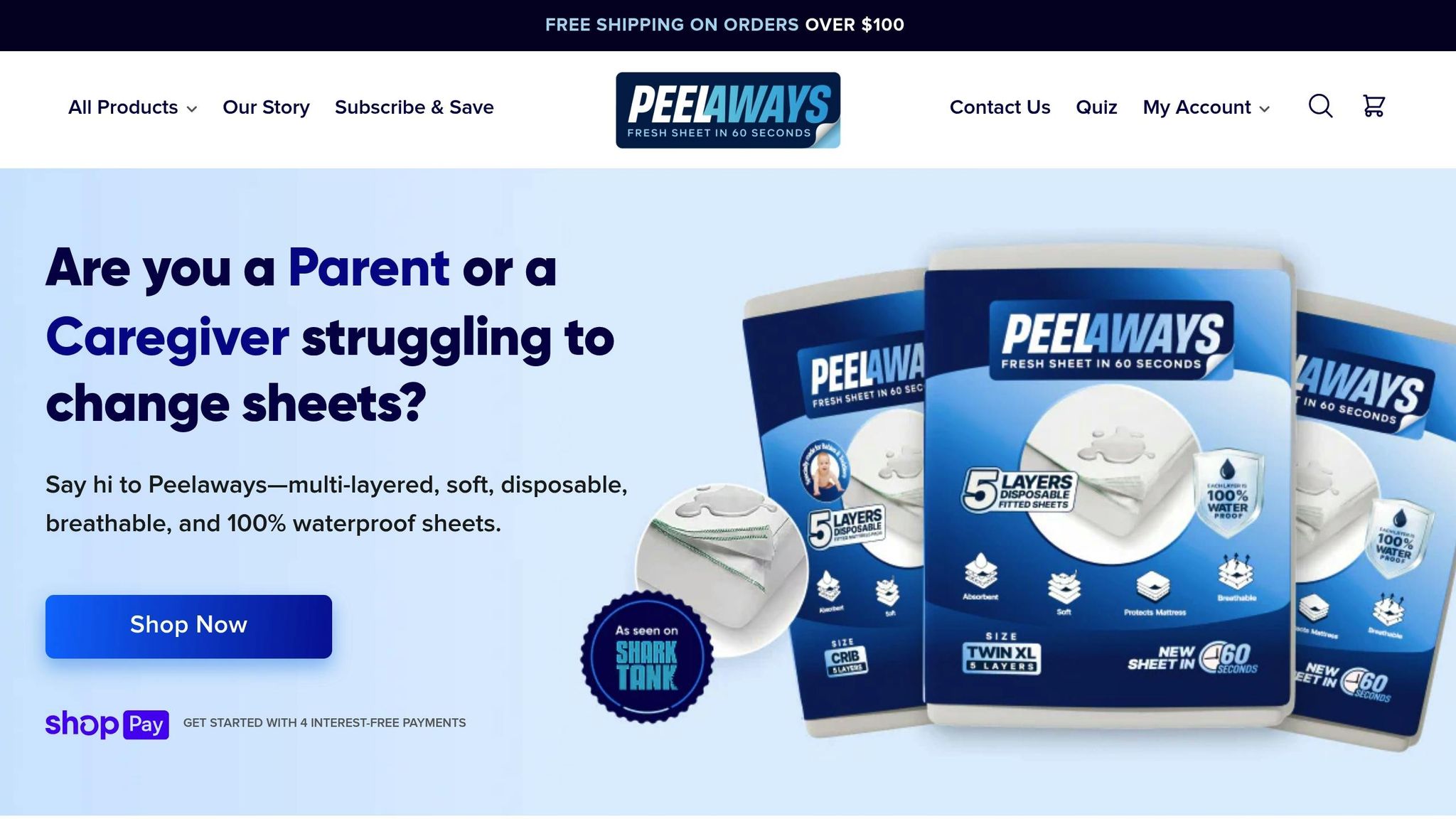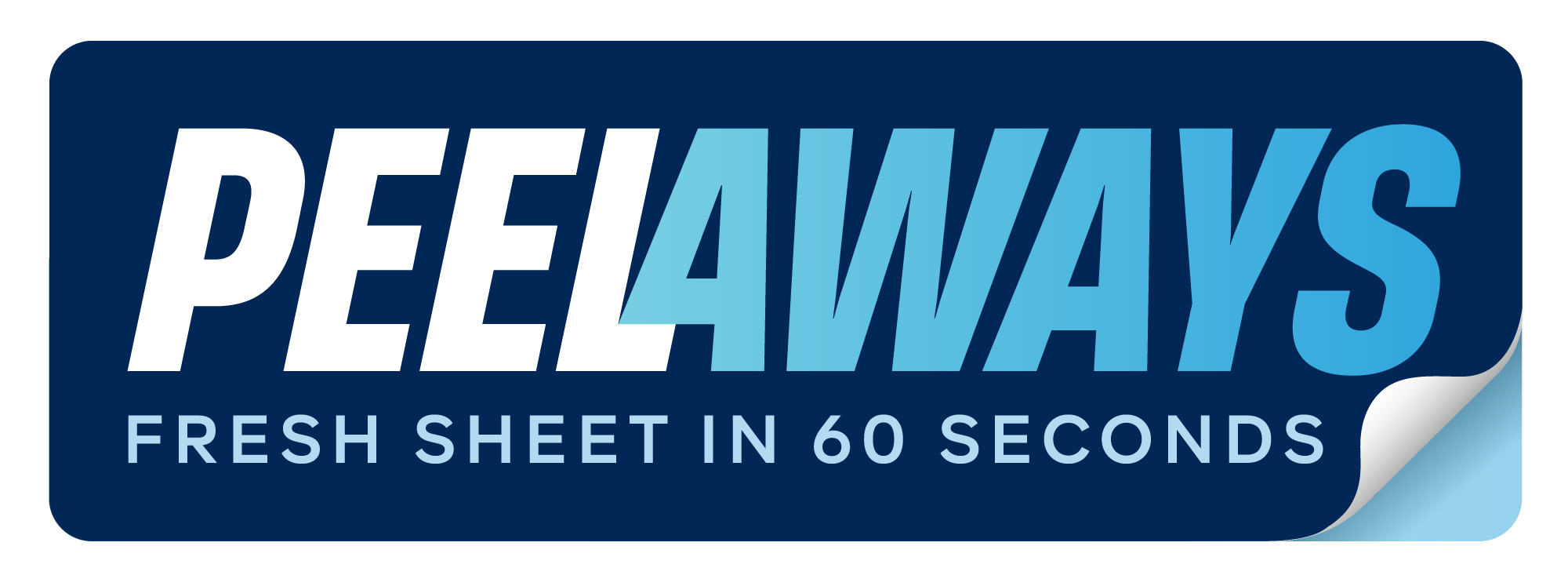Checklist for Setting Up Recovery Room Bedding

Setting up recovery room bedding is about more than comfort - it's about safety, hygiene, and supporting recovery. Here's a quick guide:
- Clean and Organize: Disinfect all surfaces, inspect the mattress, and remove clutter for a safe environment.
- Choose Waterproof Bedding: Use multi-layer options like PeelAways to simplify cleaning and protect against fluids.
- Layer for Comfort and Hygiene: Add absorbent pads, breathable top sheets, and waterproof pillow protectors.
- Ensure Accessibility and Safety: Position the bed for easy access, lock wheels, adjust height, and keep essentials within reach.
- Final Checks: Confirm bedding is clean, fitted properly, and follow proper disposal and hygiene protocols.
PeelAways sheets streamline the process with their peel-away layers, reducing laundry and contamination risks. This setup saves time, promotes hygiene, and ensures patient comfort.
BBL Bed Set Up | Vixen Plastic Surgery | Dr. Cannon

Step 1: Prepare and Clean the Recovery Room
Setting up a recovery room with a clean, well-organized environment is crucial. It not only ensures patient safety but also significantly enhances their comfort during recovery.
Clean and Disinfect the Room
A tidy and disinfected room is essential for effective care and quick response. Start by thoroughly disinfecting all surfaces with hospital-grade cleaners to eliminate bacteria and viruses.
Focus on the bed frame and mattress first, as these are in direct contact with patients and bedding. Use EPA-approved disinfectants, following the recommended contact time (usually 30 seconds to 2 minutes) to ensure proper sanitation. Skipping this step can leave harmful pathogens behind, increasing infection risks.
Pay extra attention to high-touch surfaces such as bed rails, nightstands, light switches, and door handles. These areas are hotspots for germs and can easily transfer contamination to patients or caregivers. Always clean from top to bottom to avoid recontaminating already cleaned surfaces.
Inspect the mattress carefully for any tears, stains, or odors. Even small punctures can allow fluids to seep inside, creating hidden areas for bacteria to grow - something surface cleaning alone cannot address.
Organize the Room for Easy Access
A clutter-free room is safer and more functional. Remove unnecessary furniture and personal items that could block access to the patient. Clear pathways are essential for caregivers, especially during emergencies.
Ensure the floor is free of hazards. Remove rugs or floor coverings that could cause trips or falls. Smooth, unobstructed flooring is particularly important for staff moving equipment or assisting patients who may be unsteady.
Arrange essential furniture thoughtfully. Place the bedside table within easy reach of the patient but far enough away to avoid obstructing caregivers. Maintain at least 3 feet of clearance on both sides of the bed to provide ample working space for medical staff and equipment like IV stands or wheelchairs.
Don’t overlook lighting and ventilation. Natural light can uplift a patient’s mood, but make sure brightness is adjustable throughout the day. Proper air circulation is equally important to keep the room fresh and reduce airborne contaminants.
Check Bed Height and Equipment
Adjust the bed to a transfer-friendly height, typically between 19 and 23 inches, to minimize physical strain on both patients and caregivers. Verify that all bed controls are functioning correctly.
Double-check that the bed wheels lock securely. Unlocked wheels pose serious safety risks during patient transfers or when patients are getting in and out of bed. Test each wheel to ensure it locks firmly in place.
Inspect any medical equipment needed in the room. IV poles should move smoothly and lock when necessary. If oxygen equipment is required, confirm it’s properly connected and operational. Patient monitoring devices should be positioned for easy visibility by staff without blocking access to the patient.
Lastly, make sure the call button or communication system is within the patient’s reach. Test it to confirm it connects reliably to the nursing station or caregiver alert system. Quick and effective communication is critical, especially if complications arise during recovery.
Step 2: Select and Set Up Waterproof Bedding
Once the room is clean and organized, it’s time to focus on bedding that prioritizes hygiene and safety. Waterproof bedding is a must-have in recovery rooms. It shields the mattress from spills, bodily fluids, and medications while ensuring patient comfort and maintaining cleanliness.
Choosing the Right Waterproof Bedding
When it comes to recovery room bedding, 100% waterproof protection is non-negotiable. Traditional mattress protectors can be noisy and uncomfortable, while disposable sheets offer a convenient, hygienic alternative by cutting down on laundry efforts and reducing the risk of cross-contamination.
One standout option is PeelAways disposable waterproof bed sheets. These sheets feature a patented multi-layer design, with 5 to 7 soft, absorbent layers depending on the size. Caregivers can simply peel away the top layer after it becomes soiled, revealing a fresh, clean sheet underneath. This eliminates the need to lift the mattress for cleaning and minimizes contamination risks.
PeelAways sheets come in a variety of sizes to accommodate different setups:
- Cot and Twin XL (7 layers): $34.99 and $41.99, respectively
- Standard home sizes (5 layers): Twin, Full, Queen, and King range from $34.99 to $53.99
- Crib-A-Peel (5 layers): Designed for toddlers at $30.99
When selecting bedding, consider the expected recovery duration. Longer stays may require sheets with more layers, while shorter recovery periods might only need fewer layers. The breathable, soft fabric ensures comfort, avoiding the plastic-like texture often associated with traditional waterproof options.
Once the bedding is selected, it’s time to ensure a secure fit and proper setup.
Securing the Bottom Sheet
Before fitting the sheet, make sure the mattress surface is dry and clean. Start by stretching the fitted sheet over the mattress corners, beginning at the head of the bed and working toward the foot. The elastic edges should tuck snugly under the mattress without excessive tension.
Smooth out the sheet to eliminate air pockets or wrinkles that could create pressure points. Run your hands across the surface from the center outward to ensure it lies flat.
To test the fit, gently tug at each corner. The sheet should stay firmly in place without slipping or pulling away. A loose sheet can compromise the waterproof barrier, potentially allowing fluids to seep through to the mattress. Ensure the sheet is designed to fit mattresses up to 10 inches thick.
Using Multi-Layer Sheets Effectively
Before setup, confirm the number of layers on the sheet. PeelAways sheets vary by size, with Cot and Twin XL offering up to 7 layers, while standard sizes provide 5. Count the perforated edges along the sheet border to verify the layer count.
Position the sheet with the perforated edges facing up for easy removal. The top layer should feel smooth and soft against the skin, free from any rough edges or manufacturing marks.
To remove a soiled layer, start at one corner and peel it away. The design ensures each layer separates cleanly and quickly, often without needing additional help.
Keep track of layer usage to manage inventory efficiently and avoid running out of sheets. This approach not only supports a cleaner, safer recovery process but also saves time, allowing caregivers to focus more on patient care while reducing overall costs.
Step 3: Layer Bedding for Comfort and Hygiene
Layering bedding not only enhances comfort but also helps maintain hygiene and simplifies tasks for caregivers.
Add a Draw Sheet or Absorbent Pad
After setting up your waterproof base, add another layer to protect the bed further. A draw sheet is especially useful because it safeguards against spills and makes repositioning easier. Place it across the middle of the bed, covering the area from the patient's shoulders to hips - this is where accidents are most likely to occur.
When choosing draw sheets, look for materials that complement your waterproof base. Cotton or cotton-blend options are soft on the skin and absorbent. Make sure the sheet is wide enough to tuck securely on both sides of the bed.
For patients dealing with incontinence or receiving IV medications, absorbent pads can offer additional protection. These pads are easy to replace without disturbing the rest of the bedding. Products like PeelAways sheets are a great addition, as they allow you to quickly remove a soiled layer without needing to remake the bed or adjust the draw sheet.
Use Soft, Breathable Top Layers
The top sheets and blankets come into direct contact with the patient’s skin, so choosing the right materials is crucial for their comfort and recovery. Opt for soft, breathable fabrics such as cotton, bamboo, or jersey, which allow for good airflow and wick away moisture.
Percale weave cotton sheets are particularly effective in recovery settings due to their light and crisp texture, which promotes excellent air circulation and helps prevent overheating during long periods of bed rest [2].
For blankets, lightweight thermal options are ideal. They trap heat efficiently while being easy to clean, making them practical for healthcare environments [1].
Avoid high thread count sheets, as they can trap heat despite their luxurious feel, restricting airflow [3]. Instead, focus on the quality of the material and the weave to ensure better ventilation and overall comfort.
Prepare Clean Pillows and Cases
Pillows are essential for ensuring proper spinal alignment and patient comfort during recovery. Memory foam pillows provide firm support, while fiber-filled options offer more flexibility to suit different needs.
Always use clean pillowcases for each patient, and select materials that match the breathability and softness of your top sheets. Cotton or cotton-blend cases with a percale weave help prevent heat buildup around the head and neck. For patients with allergies or respiratory issues, bamboo pillowcases are an excellent choice, offering natural hypoallergenic properties along with breathability and softness [1][3].
Keep multiple pillows on hand in varying firmness levels to meet different support needs. Having extra pillowcases ready makes it easier to swap them out when necessary.
Lastly, encase all pillows in waterproof protectors beneath the pillowcases. This added layer guards against spills, maintains hygiene, and contributes to a clean, comfortable recovery environment.
sbb-itb-45288fe
Step 4: Ensure Access and Safety
Setting up a recovery room that prioritizes safety and accessibility takes careful planning. Details like bed positioning, height adjustments, and the placement of necessary equipment play a crucial role in protecting both patients and caregivers while encouraging patient independence during recovery.
Position the Bed for Easy Access
Arrange the recovery room to ensure it’s open and free of clutter, allowing caregivers to move around easily and safely operate medical equipment. The bed should be positioned so caregivers can approach the patient from multiple angles, which is especially important for assisting those with limited mobility.
When setting up the bed, think about where medical equipment like IV stands and monitoring devices will go. These should be easy to access but placed in a way that doesn’t obstruct caregiver movement or create hazards during emergencies. Make sure the side of the bed used most often for caregiving has enough space for caregivers to work comfortably. This thoughtful setup keeps the room functional and reinforces the importance of maintaining a clean and organized recovery space.
Lock Wheels and Adjust Bed Height
Always lock the bed wheels before transferring a patient or after repositioning the bed. Regularly check and lubricate the locks to ensure they function properly and securely hold the bed in place [6][7][9]. Testing the locks periodically is a simple but essential step to maintain safety.
Adjusting the bed height depends on the activity and the patient’s needs. For electric beds, use the remote control or control panel, which typically has clearly labeled buttons for raising and lowering the bed [8]. Adjust the height carefully until it matches the task at hand [8].
| Activity | Recommended Height | Purpose |
|---|---|---|
| Patient transfers | 16–23 inches | Ensures feet can rest flat on the floor when sitting |
| Caregiving activities | 28–34 inches | Reduces strain on the caregiver’s back |
| General sleeping | Around 20 inches | Provides a secure and comfortable sleeping position |
For manual beds, locate the crank at the foot of the bed. Turn it counterclockwise to lower or clockwise to raise the bed [8]. After making any adjustments, test the height to confirm it suits both the patient and the caregiver [8]. Once the bed is secure and properly adjusted, the focus shifts to ensuring essential items are within the patient’s reach.
Keep Items Within Reach
To encourage independence and ease caregiver workload, place essential items - like the call button, medications, water, and personal care products - on a bedside table within easy reach [4][5]. The call button should be positioned so the patient can access it effortlessly, whether attached to the bed rail or securely placed on the bedside table. Make sure it’s not at risk of falling or getting tangled in bedding.
For beds with pendant controls, ensure patients can independently adjust their positioning. These controls should be nearby but secured to prevent accidental activation. Keep the control cord safely managed so it doesn’t create a tripping hazard while still being convenient for the patient to use.
Arrange frequently used items closest to the patient to minimize the need for stretching. A water bottle with a straw, for example, should be within arm’s reach, along with any medications the patient can self-administer. This setup not only boosts the patient’s comfort but also supports their recovery journey by promoting self-reliance.
Step 5: Final Check and Preparation
These final steps ensure the recovery room is fully prepared to meet patient care standards. Carefully inspect the bedding to guarantee it is safe, clean, and properly fitted. This last review wraps up the bedding setup process and ensures the room is ready for use.
Check Bedding for Cleanliness and Fit
Take a close look at all layers of the bedding to confirm they are clean, dry, and wrinkle-free. Make sure the waterproof layer remains intact and lies flat without any bunching or shifting.
For PeelAways multi-layer sheets, ensure all layers are aligned correctly. The top layer should feel soft and dry, and the perforated edges must be clean and easy to grip for when layers need to be removed. The patented design should clearly display separation lines between layers, showing the sheets are ready for use.
Gently press down on different areas of the bedding to test its absorbent capacity. The surface should feel even and stable, with no overly compressed or loose spots. This quick check helps identify any weak points that could cause issues during patient care.
Remove and Dispose of Soiled Linens
Follow a clear protocol for handling soiled bedding in line with your facility's infection control policies. For traditional linens, immediately gather and place all used items in designated laundry bags, keeping them separate from clean supplies to avoid contamination.
For PeelAways sheets, simply peel off the soiled layer and dispose of it according to your facility's guidelines. The used layer separates cleanly, revealing a fresh sheet underneath without disturbing the patient or lifting the mattress.
The biodegradable materials in PeelAways sheets naturally break down, offering an environmentally friendly option for medical facilities. This efficient process reduces the need for immediate linen changes and minimizes the risk of cross-contamination between patients. Be sure to document the disposal process as required by your facility.
Practice Proper Hand Hygiene
After handling soiled linens, immediately follow hygiene protocols. Wash your hands thoroughly for at least 20 seconds with soap and water, and dispose of gloves properly.
If required by your facility, apply an alcohol-based hand sanitizer after washing. Let the sanitizer dry completely before touching any clean surfaces or patient care items. This two-step approach provides optimal protection against contamination.
To encourage consistent hand hygiene, keep supplies like soap, sanitizer, and gloves readily accessible near the recovery room entrance and bedside. Regularly check dispensers to ensure they are stocked and functioning properly. Easy access to these materials helps staff maintain compliance with hygiene practices.
Conclusion: Simplify Recovery Room Setup with PeelAways

Setting up recovery room bedding can feel like a daunting task, but it doesn’t have to be. By sticking to a straightforward checklist, caregivers and medical staff can ensure a clean, comfortable, and safe environment for patient recovery - all while making their daily routines more efficient.
One of the biggest challenges in recovery room bedding is balancing waterproof protection with patient comfort. Traditional setups often involve multiple layers and constant linen changes, which can be time-consuming and costly. That’s where PeelAways comes in with a game-changing solution.
PeelAways sheets feature a multi-layer, 100% waterproof design that not only protects mattresses but also reduces replacement costs. When a fresh sheet is needed, staff can simply peel away the top layer, revealing a clean sheet underneath. This quick and easy process saves time, minimizes contamination risks, and allows caregivers to focus on what matters most - patient care.
With a variety of sizes available, PeelAways can standardize bedding protocols across recovery rooms, ensuring a secure fit and reliable performance. These sheets maintain their waterproof barrier throughout use, and when it’s time to dispose of them, they leave no mess behind.
What’s more, PeelAways sheets are made from biodegradable materials, aligning with healthcare sustainability goals. They break down naturally over time, offering an eco-friendly alternative to traditional synthetic bedding options while adhering to standard medical waste disposal protocols.
For healthcare administrators, the benefits are clear. PeelAways help cut costs by eliminating laundry expenses, reducing mattress replacements, and freeing up staff from time-intensive bedding changes. These savings can then be redirected to enhance other areas of patient care.
With PeelAways, recovery room bedding becomes a simple, efficient process. Their innovative design supports patient comfort while streamlining staff workflows, making them an essential tool for any healthcare setting.
Transform your recovery room setup and prioritize patient care with PeelAways.
FAQs
What makes PeelAways sheets ideal for recovery room bedding?
PeelAways sheets are a game-changer for recovery room bedding management, offering a fast, sanitary, and effortless solution. Thanks to their multi-layer design, you can simply peel away a used layer to reveal a fresh, clean surface - no need to lift heavy mattresses or deal with laundry.
These disposable, waterproof sheets are designed to minimize the risk of infection and cross-contamination, making them a practical option for caregivers and medical staff. Plus, their soft, absorbent layers not only save time but also provide added comfort for patients.
How do PeelAways sheets help maintain hygiene and prevent infections in recovery rooms?
PeelAways sheets offer a smart way to maintain hygiene and reduce the risk of infections. Their disposable, waterproof layers create a barrier that helps prevent cross-contamination. When a layer gets soiled, you can simply peel it off to reveal a fresh, clean sheet underneath - no laundry or heavy mattress lifting required.
This hassle-free design saves time while keeping the environment clean and comfortable, making these sheets a great choice for recovery rooms where maintaining cleanliness is critical.
How do I choose the right number of layers for PeelAways sheets based on the recovery period?
When choosing PeelAways sheets, think about how long the recovery period is likely to last. If it's a longer stretch, go for the 7-layer option to ensure you have plenty of fresh, absorbent layers ready to use. Each layer generally lasts about 7–10 days, depending on how it's used, making these multi-layer sheets a practical and sanitary choice for extended care needs.
Related Blog Posts
- How to Choose Bedding for Incontinence Care
- FAQs About Anti-Slip Bedding for Patients
- Common Bedding Problems in Elderly Care
- Checklist for Setting Up a Recovery Bed at Home
Comments
0

SAVE MONEY & WATER
Professionals & Institutions save a fortune on labor/laundry.

SUPERIOR COMFORT
The first thing our customers notice is how soft our sheets are.

100% WATERPROOF
Each layer is 100% Waterproof, perfect for spills and accidents

SAVE TIME
Change the sheet in under 1 minute without stripping the bed.




Leave a comment